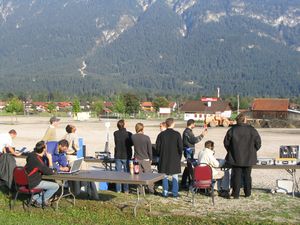Difference between revisions of "General"
| Line 2: | Line 2: | ||
__NOEDITSECTION__ | __NOEDITSECTION__ | ||
{|style="border-spacing:8px;margin:0px -8px" class="MainPageBG" style="width:100%;border: | {|style="border-spacing:8px;margin:0px -8px" class="MainPageBG" style="width:100%;border:0px solid #fff;background-color:#fff;vertical-align:top;color:#000; text-align: left;" | ||
|-valign="top" | |-valign="top" | ||
| | | | ||
<h3 style="-moz-border-radius-topright: 1em;-moz-border-radius-topleft: 1em; | <h3 style="-moz-border-radius-topright: 1em;-moz-border-radius-topleft: 1em; | ||
background:# | background:#fff;margin:0px;padding:4px;border:1px solid #000;"> | ||
[[Image:favicon32.png|32px]] General | [[Image:favicon32.png|32px]] General | ||
</h3> | </h3> | ||
| Line 13: | Line 13: | ||
</div> | </div> | ||
<!-- Start of right-column --> | <!-- Start of right-column --> | ||
| class="MainPageBG" style="width:70%;border: | | class="MainPageBG" style="width:70%;border:0px solid #000;background-color:#fff;vertical-align:top"| | ||
{|width="100%" cellpadding=" | {|width="100%" cellpadding="0" cellspacing="0" style="vertical-align:top;background-color:#fff;" | ||
|-valign="top" | |-valign="top" | ||
| <h2 style="margin:0;background-color:# | | <h2 style="margin:0;background-color:#fff;font-size:120%;font-weight:bold;border:1px solid #000;text-align:left;color:#000;padding:4px;">[[Image:favicon32.png|32px]] The Paparazzi Project</h2> | ||
|- | |- | ||
|[[Image:garmisch_paparazzies.jpg|thumb|Three Paparazzi teams at the 2005 competition in Garmisch]][http:// | |[[Image:garmisch_paparazzies.jpg|thumb|Three Paparazzi teams at the 2005 competition in Garmisch]]'''[http://paparazziuav.org Paparazzi UAV]''' (Unmanned Aerial Vehicle) is an open-source drone hardware and software project encompassing autopilot systems for multicopters/multirotors, fixedwing, helicopters and hybrid aircraft. Paparazzi, being open, enables users to add more features and improve the system. Using and improving Paparazzi is encouraged by the community. | ||
The project includes [https://github.com/paparazzi/paparazzi source-code] for the avionics and the ground station computers as well as the hardware designs for many parts of the avionics system. Paparazzi’s avionics software is designed with portability in mind. Allowing for the use of the Paparazzi UAV system on many varied hardware platforms. The ground station computer software is written in statically typed functional language assuring reliability and stability of the system. | |||
Unlike other systems, [http://paparazziuav.org Paparazzi UAV] was designed with autonomous flight as the primary focus and manual flying as the secondary. From the beginning it was designed to be able to control multiple aircraft within the same system. Paparazzi features a dynamic flight plan system that is defined by mission states and using way points as “variables”. This makes it easy to create very complex fully automated missions without the operators intervention. | |||
Since its founding in 2003, Universities and civilian teams have employed Paparazzi to win top marks in high profile airborne robotics competitions around the world; thereby, proving the flexibility, durability and advanced features embedded in the Paparazzi framework. Many of these top marks and achievements have been documented on our [http://blog.paparazziuav.org blog]. | |||
Several core developers to the project are affiliated with universities and research institutions. These include, [http://www.enac.fr/en/home ENAC University] of Toulouse, France, [http://mavlab.lr.tudelft.nl/ MAVlab] of [http://www.tudelft.nl/en/ TU-Delft] in the Netherlands and [http://aggieair.usu.edu/ AggieAir] of Utah State University in the United States. | |||
Several vendors are currently producing and selling Paparazzi autopilots and popular accessories, making the system easy and affordable for everyone. Some of the companies were founded by core developers of the [http://paparazziuav.org Paparazzi UAV project] as a way to provided well tested and integrated hardware to the Paparazzi community. For example, [http://1bitsquared.com/ 1BitSquared] is developing [http://1bitsquared.com/collections/autopilots avionics hardware] and providing consulting services for system integration, software development as well as custom [http://1bitsquared.com/collections/hardware-kits/products/lisa-s-nano-quadcopter-kit nano UAV hardware] development. | |||
Paparazzi can be used for many applications from the emerging personal UAV market to advanced hobbyists, as well as University and civilian research programs and competitions. It is also being used in the field in daily operations, for example, [[SUMO]] is being used by [http://blog.pfump.org/?lang=en meteorological researchers] as reusable weather balloons for collecting data in the Antarctic. The multitude of applications for Paparazzi are endless, so join the community and contribute to the project with your innovative ideas. | |||
|} | |} | ||
|} | |} | ||
Revision as of 15:36, 5 January 2016
|
|
